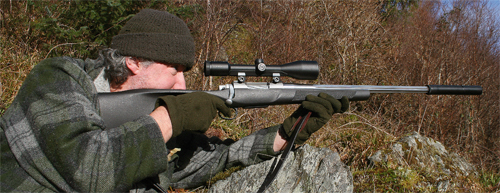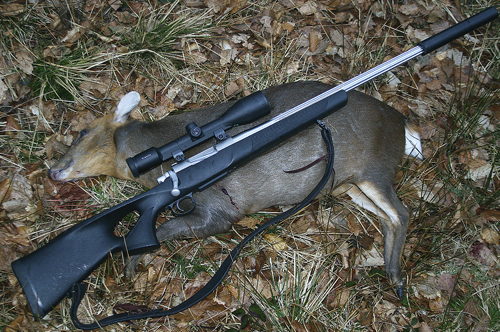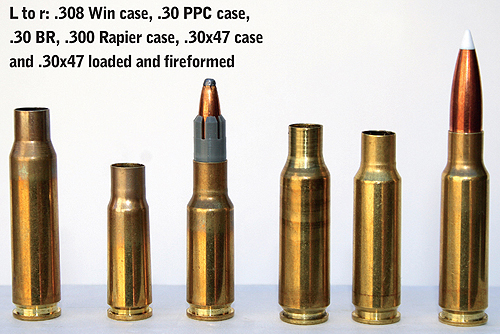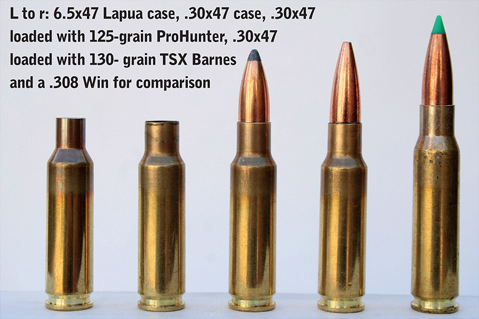Win CENS ProFlex DX5 earplugs worth £1,149 – enter here
Custom deer stalking rifle review
Custom building a deer stalking rifle allows you to tailor it to your exact needs. Here we start with the bare bones of rifle and cartridge.

The wide range of choice on offer for custom-built rifles can be overwhelming. I wanted a rugged, short, accurate, utterly reliable and weatherproof rifle primarily designed for woodland stalking but also capable of reaching distant stags on the hill. Steve Bowers has always delivered the goods for me so in this case I saw no need to change.
Action and trigger
As it was to be a stalking arm, I wanted a repeating action that had the build quality of a stainless steel bench-rest type. There are some great actions by RPA, Nesika, BAT, Barnard, McMillan, Hall and Stolle, but the Predator from Stiller suited my needs perfectly.
It’s the same shape as a Remington 700 action, so it can fit directly into a stock designed for this make. The quality of the machining is superior and it has an extended bolt handle, a pinned competition recoil lug and a fluted bolt with a Sako-type extractor.
I narrowed down the choice of triggers to three – the Jewell single-stage unit, which is superbly made, the CG Universal, which is an excellent trigger but with a two-stage operation, and the well-priced and sturdy single-stage Timney trigger.
I have used all three in the past, but because it was going to get a lot
of hard use I opted for the rugged Timney. I also like the large
trigger shoe, the safety catch and the fine single-stage operation on
the Timney.

As the Predator comes without a magazine, I had to order one separately. Depending on the stock this can be detachable or with a hinged floorplate.
I did not want to compromise on the quality of the action, so I chose an H-S Precision three-shot detachable magazine in black with a stainless steel floorplate.
Stock: practical or traditional?
There are two camps to choose from with regard to stocks: wood for the more traditionalist stalker or the less aesthetically pleasing, but more practical, synthetic type. I opted for the latter. A good fibreglass stock shrugs off bad weather, which reduces risks of inaccuracies caused by swelling wood or soft bedding.
As luck would have it, I happened to have a McMillan fibreglass/Kevlar reinforced stock in my favourite Lazzeroni Thumbhole Sporter style. Conveniently, it was shaped for a Remington 700 action, so the Predator fitted well. With a few alterations, the HS-Precision floorplate, magazine and widened barrel channel in the fore-end were all accommodated without the use of synthetic bedding.
This may sound odd, as bedding an action with synthetic compound
certainly helps accuracy and consistency, but I wanted to see how the
rifle would perform before and after proper bedding.

As far as cartridges are concerned, any one of the good factory loads such as .243, .260, 6.5×55 or .308 would have sufficed, but as I was paying for all the custom work, why not be adventurous and order a wildcat round?
I have had great success with the 6.5 Rapier, which was developed last year, but I was keen to try a .30 calibre. I have been using several cartridges based on the 6mm Swiss Match and the newer 6.5×47 Lapua, both of which I necked-down to .20 and .22 calibres five years ago for vermin work. I never got around to having a barrel chambered for the same cases necked-up to .30 calibre for deer, however.
The new round was a 6.5×47 Lapua necked-up to .30 calibre with a case capacity between that of a .30BR and a standard .308Win. This means it can launch medium-weight .30 calibre bullets at deer-legal velocities and energies from a relatively short barrel with the minimum of powder being burned.
I opted for a stainless steel Walther barrel with a one-in-10 twist-rifling rate. It was fluted for good looks and to reduce the weight.
Simple case forming
The case reforming is very simple. I expanded virgin 6.5×47 case necks in three stages using Sinclair expander mandrels. I lubricated cases and mandrels with Imperial sizing wax.
I started with a .270 sizing mandrel followed by a .284 (7mm) and finally a .30 mandrel. A small doughnut of excess brass at the base of the neck resulted from the expansion, but you can turn the case to reduce the thickness.
The chamber reamer has a 0.336in neck diameter, allowing 0.0025in of clearance on either side of the 125-grain bullet, which has a diameter of 0.331in, thus negating the need for turning it. All you need to do, therefore, is deburr the case mouth inside and out and load up a round so that the bullet is touching the lands.
The round should be 2.6545in long overall with a 125-grain Nosler Ballistic Tip bullet. After fire forming, the new case fitted exactly into the rifle’s chamber. The result was a superbly efficient deer cartridge with unusual ballistics.
Load development
But does the cartridge work? Due to the lighter bullets being used and the shorter-than-average 20in barrel, I used powder with faster burning rates such as Vit N130 or Reloder 10X.
I settled on a starting load of 38 grains of Reloder 10X with 150-grain Sierra GameKing bullets. This produced a healthy 2,711fps and 2,449ft/lb energy. The 150-grain Nosler Ballistic Tip was not far behind at 2,683fps and 2,398ft/lb. Speer Deep Shok produced 2,724fps and 2,472ft/lb, and Nosler Accubond 2,737fps and 2,496 ft/lb – good performances with only 38 grains.
Upping the powder weight to 39 grains only yielded another 47fps velocity and there were faint pressure signs on the case, so I stopped at 38 grains. The accuracy was superb.
The largest group was the Ballistic Tip at 0.92in, followed by the Speer Deep Shok bullet at 0.85in for three shots at 100 yards. The Nosler Accubond clustered into 0.68in and the venerable old GameKing out shot the lot with three shots in less than 0.45in.
Two 130-grain bullets were next. The first was a Barnes TSX, which travelled at 2,869fps with 2,377ft/lb of energy. This was launched with only 38 grains of Reloder 10X. The Hornady 130-grain SP sped along at 2,819fps, yielding 2295ft/lb energy.
Again accuracy was good with three-shot groups all within 0.75in from 100 yards.
The Sierra 125-grain Pro-Hunter bullet, which is similar to the Sierra GameKing but has a flat base, was slower than the heavier 130-grain at 2,780fps and 2,146 ft/lb energy. However, it shot superb 0.45in groups. The lighter 110-grain V-Max bullet was more suitable for foxes and had lower velocities than expected at 2,891fps with 2,042ft/lb energy.
This was the result of a low maximum powder weight for this type of bullet and the powder being a little slow. With the 125-grain bullets, 41 grains of Vit N130 produced 3,026fps and 2,541ft/lb energy. The 110-grain V-Max sped along at 3,160fps and 2,439ft/lb energy with 43 grains of Vit N130 powder. The accuracy was not as good as with the heavier, slower velocity bullets, so a little fine tuning would be needed for these.
In the field
Before assessing the rifle’s performance on muntjac out in the field, I mounted a Zeiss 7×50 illuminated reticule scope to the Predator’s action. Because the Zeiss uses a rail mount system and not the conventional ring mounting, I used a set of EAW/Apel rail mounts to fix the scope.
I always opt for accuracy over velocity and plumped for the 125-grain Sierra Pro-Hunter as I had run out of 150-grain GameKing. Zeroed at 100 yards, the 125-grain Pro-Hunter with a sedate 38 grains of Reloder 10X shot 1in low at 150 yards and 3.6in low at 200 yards.
On hitting the target, I was hoping the 125-grain bullet would provide a combination of non-excessive expansion and a good amount of kinetic energy from the heavier .30 calibres. My first muntjac was taken on an April morning in Buckinghamshire. The large doe did not twitch as the Pro-Hunter found its mark. It was a slightly angled and forward heart shot from 60 yards.
Upon gralloching the carcass I discovered little meat damage yet the heart was pulverised and a 1.5in exit wound proved the effectiveness of the .30×47 Lapua round.
CONCLUSION
With a minimal powder charge and decent weight the .30 custom-built rifle harvested muntjac and roe effectively at legal velocities with only mild recoil. Is it any better than a .243 or down-loaded .308 with correct bullet weights? The answer is no, probably not, but that’s not the point. Life would be boring if we all shot the same cartridge or calibre and there is always room to improve the status quo, even if only fractionally.
Furthermore, even for the staunchest of technophobes the wildcat is a simple one to make. The accuracy of the rifle and cartridge proves that despite the long wait and high price, custom rifles really are worth it.
SUPPLIERS
– Steve Bowers, custom work, tel 01242 863005
– Jackson Rifles, Timney, Jewell, C-G Universal triggers and McMillan stocks, tel 01644 470223
– JMS Arms, PES/MAE moderators, tel 07771 962121
– TWG, Predator actions, tel 07590 533020
– Viking Arms, H-S Precision equipment, tel 01423 780810
– Zeiss UK, Zeiss 7×50 scopes, tel 01707 871350
– Sentry Trading, EAW/Apel mounts, tel 01494 463466
– Norman Clark, Reloading components, tel 01788 579651
Read more rifle reviews!
Related Articles
Get the latest news delivered direct to your door
Subscribe to Shooting Times & Country
Discover the ultimate companion for field sports enthusiasts with Shooting Times & Country Magazine, the UK’s leading weekly publication that has been at the forefront of shooting culture since 1882. Subscribers gain access to expert tips, comprehensive gear reviews, seasonal advice and a vibrant community of like-minded shooters.
Save on shop price when you subscribe with weekly issues featuring in-depth articles on gundog training, exclusive member offers and access to the digital back issue library. A Shooting Times & Country subscription is more than a magazine, don’t just read about the countryside; immerse yourself in its most authoritative and engaging publication.









